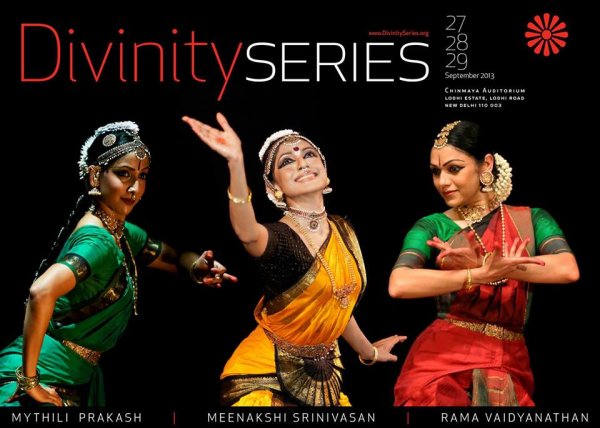
|   |

|   |
Soul stirring immersion in Bharatanatyam - Aparna Mathur e-mail: aparna94@gmail.com October 28, 2013 The Divinity Series organized by Deepak and Jyotsna Shourie from 27th to 29th September 2013 at Chinmaya Mission, Delhi, was a soul stirring immersion in Bharatanatyam.  Rama Vaidyanathan inaugurated the festival with her graceful Mayura allaripu skillfully capturing the subtle movements of a peacock to recreate its magnificence through dance. In another composition, Lord Rama discloses to his wife Sita that he has been banished from the kingdom and would proceed all by himself. How can you even dream of leaving without me, she implores. Consumed by hurt she asks him how she could live the life of luxury within the palace precincts while her husband roamed the jungles surrounded by wild animals. Rama’s depiction of shock, bewilderment and deep pain that Sita experiences, was so authentic. And then she takes a jab at the male ego by saying, “If you are planning to leave your wife, what kind of a man are you?” Sita, the quintessential Indian woman, the power of her love and dedication to her husband was so palpable. And she spares no opportunity to strike back when her love is under attack. All three artistes of the festival chose to depict the sacred and the indomitable feminine shakti, symbolized by their unending fortitude, passion and surrender. In the padam, Radha is trying to silence her lover Krishna by asking him to stop playing the flute. A playful Krishna continues to trouble her. While she tells him to go away lest the neighborhood would wake up, one can see a part of her also enjoying the attention she has been getting. The brilliance of the dancer is seen in the way she balances the nayika’s annoyance with a coy expression of her delight. With her captivating abhinaya she is able to hold the attention of the audience enabling one to completely absorb the sentiments of the nayika. Her ability to get under the skin of the characters she portrays, whether it’s a graceful bird, the jilted nayika or the elephant like gait of the nayaka is remarkable. In the last piece Shivoham, Rama dazzled with the brilliance of her nritta. Meenakshi Srinivasan commanded the stage like it was her world and played the many roles with effortless grace and perfection. She drew in the viewer by her stylized narration, almost like lyrical poetry. While each composition was breathtakingly beautiful, her padam on Radha and Krishna was a sensual piece depicted with poignant charm. Radha urges Krishna to re-apply the kohl in her eyes that have been smudged during a night of passion. She is not ashamed of the love marks on her body and asks the Lord to soothe them with sandalwood and musk. The beauty of this piece could be appreciated by the dancer’s evocative abhinaya, a slow and soft composition that explored the depths of the feminine persona -unabashed in love, bold in her requests, yet shy and graceful in her demeanor. On the final day, the dance enthusiasts of Delhi were treated to a delightful performance by US based dancer Mythili Prakash. In the ashtapadi, Radha’s sakhi shares her pain of separation from her beloved Krishna. The theme of separation is not an uncommon subject and has been depicted very often through dance and drama. Yet it continues to tug at your heartstrings. Mythili’s ability to express this deep anguish could make one touch the depths of the rasa and be one with the bhava of the nayika. Her concluding piece was a befitting closure to the festival on divinity. Tarana in raag Natabhairavi, composed by maestro Pandit Ravi Shankar was a prayer for Inner Awakening. He Nath, hum par kripa keejiye - she urges the Lord to help us find the space within that transcends the physical realm to reach out to our higher purpose. Trained in Bharatanatyam for the last twelve years, Aparna Mathur is currently learning at The Dance Centre, Delhi. As a leadership consultant, she works with a wide cross section of people in helping them tap their potential. She hopes someday to leverage the arts, in particular dance to enable the above. |